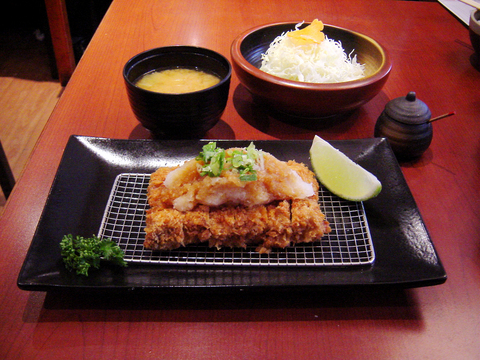If you think most Taipei urbanites are stuck in the rat race and would be too busy to stand in line for over 30 minutes to secure a pork chop for lunch, check out the tonkatsu eatery hidden behind the Cathay General Hospital on Renai Road. A beneficiary of the influence wielded by bloggers and online chat room gossipers, the restaurant's sets, consisting of a breaded, deep-fried pork cutlet served Japanese-style, are hot property.
Is the wait worthwhile?
Dinners can choose to fill up on the popular Japanese meal in two ways: traditional or innovative.

PHOTO: HO YI, TAIPEI TIMES
One option is pork chop served with daikon, or white radish, mash.
If simplicity is not your style, the restaurant does a range of pork cutlets stuffed with various fillings. For NT$310, patrons can make their own combinations of pork chop with two choices from over 10 options including cheese, kimchi, tuna salad, egg, crab meat and curry sauce.
Cheese tonkatsu seems to be the restaurant's tour de force. In one bite, the gooey cheese coats the chop's crispy layer and succelent meat creating a sumptuous trio of textures. The cheese and curry chop, on the other hand, tries too hard, and packs too much of a punch with a confusing array of flavors.
The kimchi option is sour, sweet, spicy and piquant, without one flavor dominating the dish. For those who want a feast for the eyes as well as one for the stomach, the laver and steamed eggs set and the plum sauce and crab option are must-tries.
Adding condiments to the meal is a treat in itself as diners are provided with pestles in which to grind white sesame seeds and other spices.
Fresh shredded cabbage, miso soup and high-quality rice come in unlimited supply with the sets.
As the establishment is pretty much full day and night, weekdays and weekends, the motto of the wait staff is to serve up the fare as quickly as possible with passable courtesy. Dishes are served at an admirable speed while wait staff politely ask permission to clean up empty plates from time to time. It is not an ideal venue for a lengthy tete-a-tete with an old lover. Don't hesitate to prevent the eager wait staff from taking away your half-finished food and be careful with the mustard dressing, it is fiery stuff and could have you wincing and blubbering through your entire meal.

In Taiwan there are two economies: the shiny high tech export economy epitomized by Taiwan Semiconductor Manufacturing Co (TSMC, 台積電) and its outsized effect on global supply chains, and the domestic economy, driven by construction and powered by flows of gravel, sand and government contracts. The latter supports the former: we can have an economy without TSMC, but we can’t have one without construction. The labor shortage has heavily impacted public construction in Taiwan. For example, the first phase of the MRT Wanda Line in Taipei, originally slated for next year, has been pushed back to 2027. The government

July 22 to July 28 The Love River’s (愛河) four-decade run as the host of Kaohsiung’s annual dragon boat races came to an abrupt end in 1971 — the once pristine waterway had become too polluted. The 1970 event was infamous for the putrid stench permeating the air, exacerbated by contestants splashing water and sludge onto the shore and even the onlookers. The relocation of the festivities officially marked the “death” of the river, whose condition had rapidly deteriorated during the previous decade. The myriad factories upstream were only partly to blame; as Kaohsiung’s population boomed in the 1960s, all household

Allegations of corruption against three heavyweight politicians from the three major parties are big in the news now. On Wednesday, prosecutors indicted Hsinchu County Commissioner Yang Wen-ke (楊文科) of the Chinese Nationalist Party (KMT), a judgment is expected this week in the case involving Hsinchu Mayor Ann Kao (高虹安) of the Taiwan People’s Party (TPP) and former deputy premier and Taoyuan Mayor Cheng Wen-tsan (鄭文燦) of the Democratic Progressive Party (DPP) is being held incommunicado in prison. Unlike the other two cases, Cheng’s case has generated considerable speculation, rumors, suspicions and conspiracy theories from both the pan-blue and pan-green camps.

Stepping inside Waley Art (水谷藝術) in Taipei’s historic Wanhua District (萬華區) one leaves the motorcycle growl and air-conditioner purr of the street and enters a very different sonic realm. Speakers hiss, machines whir and objects chime from all five floors of the shophouse-turned- contemporary art gallery (including the basement). “It’s a bit of a metaphor, the stacking of gallery floors is like the layering of sounds,” observes Australian conceptual artist Samuel Beilby, whose audio installation HZ & Machinic Paragenesis occupies the ground floor of the gallery space. He’s not wrong. Put ‘em in a Box (我們把它都裝在一個盒子裡), which runs until Aug. 18, invites